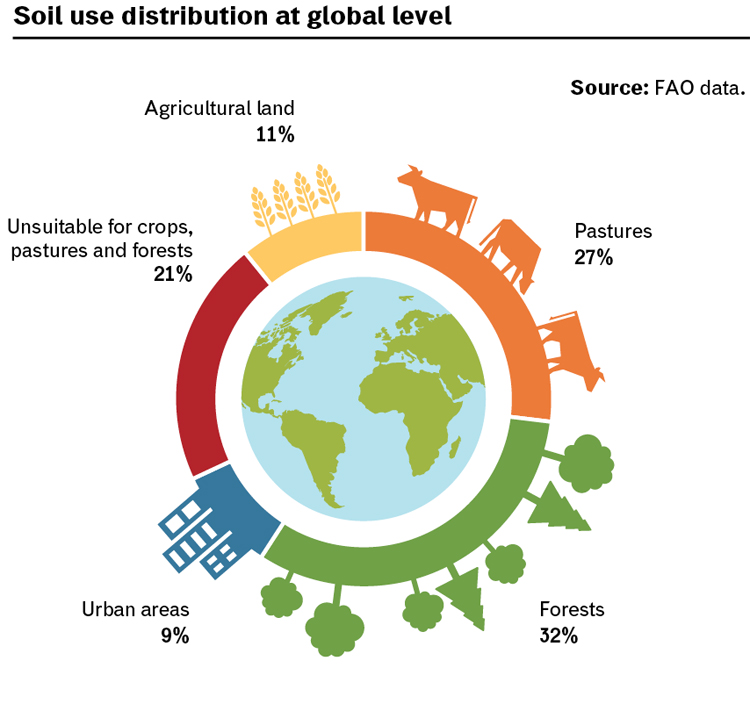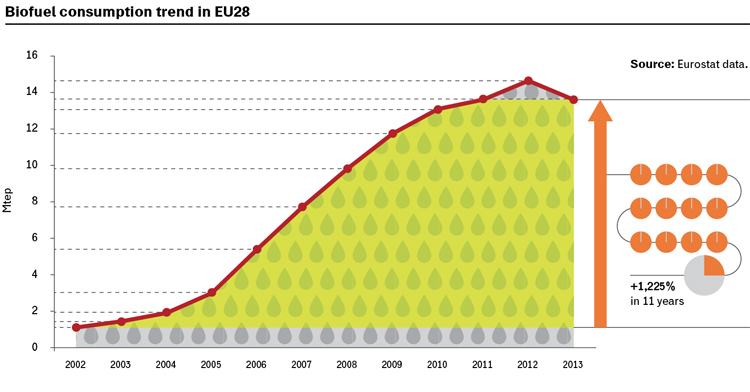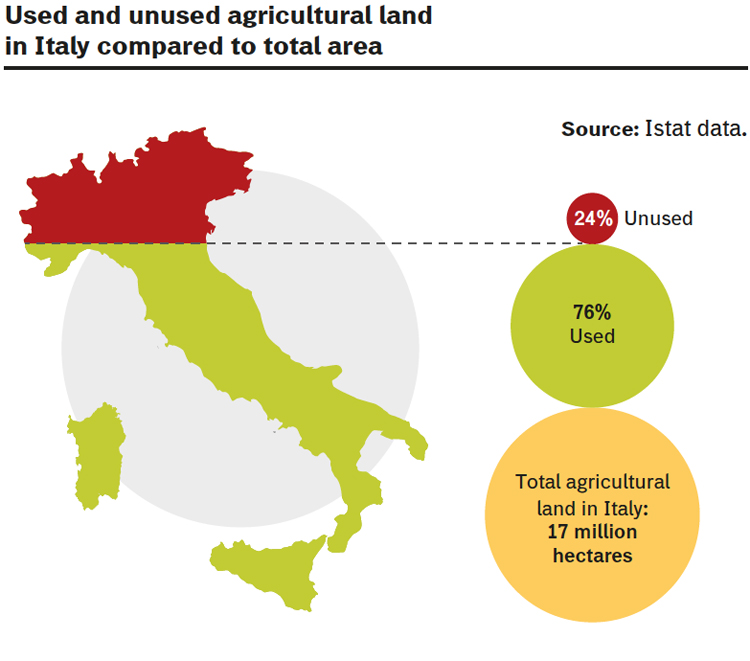At global level, biomass currently amounts to 10-12% of energy production: it is the first amongst renewables and it has an enormous expansion potential both for the production of heat and electricity and in the transport sector. However, this is not enough. The challenge is to produce biomass sustainably (avoiding the conflict with food needs) and to adopt a more efficient and technologically more advanced use (at present, only 40% of available raw material is used with the current knowhow and technology at our disposal).
It is an unavoidable challenge because, despite the above-mentioned problems, the interest towards the bioenergy sector keeps growing for two reasons: increasing fossil fuel prices and concerns about the security of energy supplies. This push thus calls for a careful analysis of this sector and its potential. Here are some salient points.
Green Chemistry
The use of biomass as a renewable source can be obtained by recycling residual vegetable raw materials deriving from forest maintenance and agricultural residues to wood industry and the agricultural and food industry waste. Alternatively, by producing it with ad hoc energy crops.
Most biomass is still used directly for heating, especially in developing countries. However, it is its technologically advanced uses that attract most interests. Let us talk about green chemistry: biomass, thanks to advanced chemical processes, can be turned into substances that can be used to produce a vast range of intermediate compounds from which other products (biobased products) and energy are obtained.
Soil Consumption
Unfortunately, at present more than half of the available residual vegetable matter goes to waste, concentrating on biomass obtained from energy crops. This is how the majority of commercial liquid biofuels are produced: from sugar cane, maize and other cereals, beets and other oleaginous crops.
This would be enough to understand the existing potential conflict between energy and food crops to meet in the near future the food needs of a fast increasing world population.
Soil – necessary both for cultivating food and energy crops – is a precious as well as a scarce resource.
Globally, most available land for the production of biomass is already used; without taking into account that more than 20% of the total surface (13 billion hectares) cannot sustain either crops, pastures or forests for climatic reasons.
It is impossible thinking of meeting energy requirements only with dedicated biomass crops because we would need enormous amounts of land. In some countries where this possibility has been taken into account – such a research study on the production of biofuels has been carried out in the USA – it has emerged that the available land would not be enough to produce fuel for the existing vehicles.
We must not forget that the potential competition between bioenergy and food crops is not limited to soil use but it also entails water consumption, fertilizer use and labour.

Impacts
Besides, subtracting land that could be used to produce food, intensive cultures for biofuels have an adverse impact on local biodiversity and promote the expansion of energy monoculture in non-agricultural areas causing deforestation.
We must also take into consideration the not always positive balance between the energy necessary to produce biofuels and the energy that can be obtained from them. Just one example. From a water point of view, the production of 1 litre of biodiesel requires a total of 4,000 litres of water, including that necessary for crop irrigation and that used in the chemical transformation process.
This is to point out that the bioenergy production risks must be assessed according to each country and region’s characteristics. In order to assess the pros and cons of investing in this sector, FAO has devised a new method called “Bioenergy and Food Security Analytical Framework”.
This method enables to assess the bioenergy production potential in a specific context while evaluating possible impacts considering the development project feasibility, its repercussions on food availability and security and on social and environmental aspects.
Exploiting Marginal Areas
To reduce soil consumption and its impacts and in order not to subtract land from food crops, a tangible solution for bioenergy crops is to use marginal lands. We are talking about areas that due to their climatic, pedological or cultivation characteristics are unsuitable for traditional agricultural uses.
Some examples of marginal areas include exhausted or dismantled open-pit quarries or mines, closed or abandoned landfills. As well as polluted and degraded areas, dismantled industrial areas, croplands that have never been sown and with no vegetation, former military sites and land unsuitable for crop, forest and pastures uses included in the lowest classes of land capability.
These are areas, that contrary to what one could think, can be put to good use and become productive. For example, some plants are able to grow well even in soils polluted with heavy metals. Another possibility is to irrigate energy crops in these areas with wastewaters thus achieving great water consumption benefits without subtracting water from potable and agricultural uses.
The European Target: 10% of Biofuels
From 2002 to 2012, the consumption of biofuels for transport in the EU28 grew constantly stabilizing at about 13.6 Mtep in 2013. The European target is to achieve a mix of fuels containing 10% of biofuels by 2020.
This increase in consumption has had two consequences. On the one hand, it has promoted the import of raw materials and/or finished product – mainly ethanol – from non EU countries. On the other, thanks to EU’s incentives on biofuels, it has caused the indiscriminate conversion of a lot of agricultural land, subtracting it from food production. In Germany, the Netherlands and France where rape is the main crop for biofuels, more than 60% of this crop is grown for such purpose.
In reality, with the new CAP and the uncoupling of aid and land use, European farmers have several choices to increase biomass production, avoiding further soil consumption. For example, including energy crops in the rotation or using soils not suitable for growing food crops but that thanks to this could be recovered.

The Italian Panorama
Over the last few years in Italy the production of biomass for energy and industrial uses has increased constantly. According to the National Action Plan on Renewables, biomass should meet – with regard to the total energy production from renewable sources – 19% of total electricity consumption, 54% of heating and cooling needs and 87% of transport requirements.
For the production of thermal energy and/or electricity, the most used biomass is essentially wood (about 23 million tons per year, of which circa 83% is used for heating) and forest, agricultural and agro-industrial residues.
In Europe, Italy ranks fourth in the production of biofuel, after Germany, France and Spain, with a production capacity of over 2 million tons per year (2011 data).
Unfortunately, the potential of the Italian industry is largely underexploited: incentive measures in place in some non EU countries make it cheaper to buy biofuel from foreign suppliers. As a result, despite a stable production, the increasing market demand is met more and more by imports.
In order to reverse this trend and to best exploit Italy’s production potential, it is necessary to stimulate a more efficient production of biomass while increasing the recovery of residual biomass. In other words, recovering widespread waste, quantitatively important, from the agricultural (pruning), forest (forest residues) and agro-industrial (shells, olive pulp) sector, that often is not utilized or destroyed inappropriately.
In Italy, the two main crops currently grown for energy production are rape (80%) and sunflower (20%). But in reality there are no exact data on energy crops that seem nearly ignored by official statistics.
If we exclude poplar cultivation for pellet production, other crops used to produce biofuels (rape, sunflower and soya) or to generate biogas (maize, sorghum and triticale) can not be differentiated from other similar food crops from which they differ only for the end use.
In Italy, they have never been widespread. This was not due to a lack of interest by farmers or of land but because the market did not repay adequately the costs incurred by farmers compared with the traditional market of food crops.
Conservation agriculture can undoubtedly play a positive role in the exploitation of energy crops. For example, using hilly areas with no vegetation cover after harvesting cereals and other vegetable produce that during the autumn-winter period are more prone to water erosion.
It could also be useful to adopt short rotation forestry (SRF), that is single or multi-stemmed trees of fast growing species grown on a reduced rotation length.
Marginal areas contribution could also be crucial.
In Italy the total surface available for bioenergy crops amounts to 1-2 million hectares, of which 200,000 are untilled public areas that very often the public administration does not know what to do and in this context they would be a precious resource.

Exhausted open-pit quarries and mines are the best bet; they could produce 3% of the national energy requirements, followed by landfills, contaminated areas and military sites.
In Sicily and in Sardinia some projects exploiting dismantled old industrial sites are already in place: damaged and polluted areas where Giant cane (Arundo donax) is grown.
The “From marginal to renewable energy sources sites” (M2RES) Project is also based on the recovery of degraded areas. The proposed system promotes the reduction of biofuel production costs, the quantity of water and fertilizers without compromising food resources available to consumers.
The project includes the use of autumn-sowing crops able to grow even with little water; soils normally unsuitable for the cultivation of food species (marginal and premontane areas); complete exploitation of by-products to increase energy efficiency using the same amount of water, herbicides, fertilizers and labour; rotation with some specific leguminous plants, also suitable to grow in dry farming conditions, to avoid organic matter depletion in the soil. It excludes soils where in the last three years human and animal food crops have been grown, those belonging to the Class I and II of the land capability classification as well as soils for quality crops, for organic crops or EU-protected labels.
Bibliography
- “Biofuels Barometer”, Eurobserv’er, 2014; www.eurobserv-er.org
- Di Mario F., G. Braccio, V. Pignatelli, N. Colonna, F. Zimbardi, Quaderno Biomasse e Bioenergia, ENEA, 2011
- Meneghello G., “Biofuel, al 2020 il 10% sarà di seconda generazione” interview with Vito Pignatelli, Qualenergia.it, September 21, 2011; www.qualenergia.it/articoli/biocarburanti-biofuel-la-seconda-generazione-2020-Pignatelli-Enea-etanolo-ligno-celulosico
- Khwaja Y., I. Maltsoglou, “Agriculture, bioenergy and food security: using BEFS to guide agricultural change”, Bioenergy and Food Security – The BEFS analysis for Tanzania, FAO, Environment and natural resources management working paper n. 35, 2010, pp. 13-22
- “M2RES - Transforming marginalities into RES opportunities: experiences and lessons learnt”, South East Europe Programme, 2014; www.m2res.eu
- Maddalena L., Lo sviluppo delle energie alternative: il caso Puglia, Franco Angeli, 2012
- “Solid Biomass Barometer”, Eurobserv’er, 2015; www.eurobserv-er.org
- Supply Chain round table for bioenergies. DM 9800 of 27th April 2012, “Workshop n. 1 Biomasses - Biofuels and bioliquids - Biogas and biomethane - Green Chemistry”, Stato dell’arte della bioenergia in Italia, June 2014;
www.itabia.it/doc/pdfRapporto_Stato_filiere_bioenergetiche_GR1.pdf



